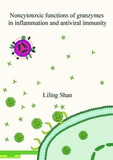Noncytotoxic functions of granzymes in inflammation and antiviral immunity

Shan, Liling
- Promoter:
- Prof.dr R. (Roel) Goldschmeding
- Co-promoter:
- Dr A.N. (Niels) Bovenschen
- Research group:
- Bovenschen
- Date:
- September 8, 2020
- Time:
- 14:30 h
Summary
Noncytotoxic functions of granzymes in inflammation and antiviral immunity
Cytotoxic lymphocytes, including cytotoxic (CD8+) T lymphocytes, natural killer (NK) cells, NKT, and gamma delta (γδ) T cells, play crucial roles in inflammation, antitumor, and antiviral immunity. Upon activation, cytotoxic lymphocytes mainly employ the granule exocytosis pathway to destroy target cells. They release a pore-forming protein perforin and a family of five structurally homologous serine proteases called granzymes (GrA, GrB, GrH, GrK, and GrM) that display distinct substrate specificities towards target cells. Perforin makes pores in the cellular membrane to facilitate entry of granzymes into target cells, where granzymes can exert intracellular functions, such as inducing cell death and noncytotoxic viral inhibition. In addition, granzymes can also exist extracellularly, where they perform proinflammatory functions and extracellular matrix modification.
Proinflammatory function of granzymes
In chapter 2, we evaluated the roles of GrK and GrM in the pathogenesis of rheumatoid arthritis (RA). We found that serum GrK and GrM levels are not changed in RA, whereas GrM, but not GrK, levels are elevated in synovial fluid of RA patients. We showed that GrM is mainly expressed by cytotoxic CD8+ T cells, NKT, γδT, and NK cells in synovial fluid-derived mononuclear cells. In addition, we showed that GrM levels in synovial fluid correlate with local proinflammatory cytokine IL-25, IL-29, XCL1, and TNFα levels. Mechanistically, we found that purified GrM triggers the release of IL-29 (IFN-λ1) from human fibroblasts in vitro. Thus, our data point to a novel mechanism by which intra-articular GrM, likely produced by (cytotoxic) cells, may contribute to RA disease progression by locally inducing proinflammatory cytokine IL-29.
In chapter 3, we reflect on a previously published paper ‘Granzymes A and K differentially potentiate LPS-induced cytokine response’ of our research group. We discuss a novel proinflammatory role of GrA in modulating TLR signaling and potentiating proinflammatory cytokine release during bacterial infections. The mechanism employed by GrA to enhance LPS-induced cytokine release from monocytes does not involve binding to LPS and LPS-CD14 complex formation, and does only marginally liberate LPS from micelles. This is in marked contrast to GrK.
Noncytotoxic antiviral functions of granzymes
Human cytomegalovirus (HCMV) belongs to the β-herpesvirus family and is characterized by an asymptomatic lytic and a subsequent life-long latent infection in immunocompetent individuals. However, it can trigger devastating disease following HCMV reactivation in immune-suppressed patients (e.g. stem cell transplant recipients and HIV-infected patients). In addition, HCMV infection is the most frequent viral cause of congenital defects and may promote cancer.
In chapter 4, we investigated whether cytotoxic lymphocytes can use granzymes to control HCMV infection in a noncytotoxic manner. We demonstrated that CD8+ T cells and NK cells can inhibit HCMV dissemination independent of host cell death and IFN-α/β/γ. We showed that cytotoxic lymphocytes induce the degradation of HCMV immediate-early (IE) proteins IE1 and IE2, which are essential players in initiating viral replication, in virus-infected cells before killing occurs. Despite human granzymes display distinct substrate specificities, we found that all human granzymes can directly target viral IE1/2 proteins at multiple cleavage sites, resulting in the inactivation of their functions and thus HCMV replication. Our data indicate that killer cell proteases can control HCMV infection in a noncytotoxic manner via targeting indispensable viral proteins.
In chapter 5, we examined whether cytotoxic cells can restore cGAS-STING signaling and host cell IFN-β response during HCMV infection. Previously we have demonstrated that NK cell-derived GrM can cleave the HCMV tegument protein pp71, which has recently been identified to inhibit cGAS-STING-mediated antiviral IFN-β response. Now we showed that NK cells can use GrM to inactivate pp71, thereby restoring cGAS-STING signalling and IFN-β response in HCMV-infected cells. We proved this by using a HCMV-pp71L439A mutant virus, which is resistant to GrM-mediated proteolysis, and GrM-knockout NK cells. Mechanistically, GrM cleaved pp71 into a long (L) and short (S) fragment, of which pp71 L can not inhibit IFN-β production and further outcompetes pp71-mediated STING signalling, pp71 S still inhibits the cGAS-STING-IFN-β pathway, but is rapidly degraded by the proteasome.
In chapter 6, we developed a specific granzyme sensor to investigate cytotoxic cell-target cell interactions and their spatiotemporal dynamics. We constructed a granzyme sensor named iGrMMer to image GrM delivery inside tumor cells at single cell level. This sensor is green fluorescence because of a constitutively active green fluorescent protein and obtains infrared fluorescence upon GrM-mediated cleavage. We showed that iGrMMer is specific for GrM and does not cross-react with other granzymes or caspases. We also showed that target cells transgenic for green iGrMMer acquire infrared fluorescence following intracellular delivery of purified GrM. This provides a promising tool for visualizing cytotoxic cell-target cell interactions and their spatiotemporal dynamics during antitumor and antiviral immunity at single cell level in vivo.
In conclusion, we have generated new insights into the noncytotoxic functions of granzymes in inflammation and antiviral immunity, and provided a potentially beneficial tool to assist visualizing the interactions between cytotoxic cells and target cells in the future.